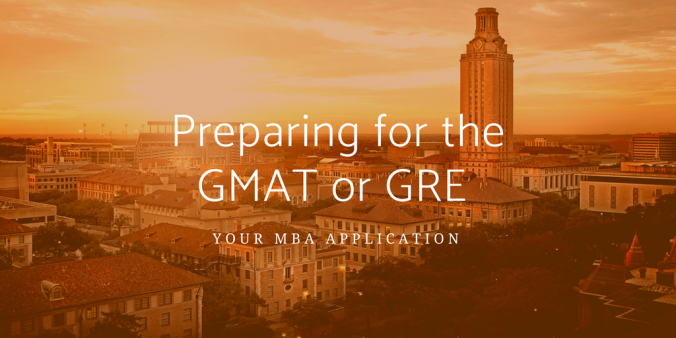This is the first in a four-part series of posts on GMAT/GRE testing. We encourage you to review all posts. This content was written by Dave Jackson, Senior Admissions Officer, Dallas/Fort Worth MBA.
It can be the most stressful part of an MBA application-– the requirement to take either the Graduate Management Admission Test (GMAT) or the Graduate Record Exam (GRE).
At McCombs, the Admissions Committee does not waive this requirement for any of our Working Professional MBA programs (Dallas/Fort Worth, Houston, or the Austin Evening programs) or for our Full-Time program.
So your first question will be: Which test do I take?
Like coffee vs. tea, or vanilla vs. chocolate ice cream, the choice is entirely yours. We have no preference, though more of our students end up choosing the GMAT because it is designed to prepare candidates specifically for business school. And some professions, like consulting and investment banking, do prefer that you have a GMAT score to report. (More on this can be found in our third post of this series.)
While both tests have quantitative and verbal sections, they have noticeable differences. We encourage you to do your research and take practice tests to learn each test’s points of emphasis, and how they are scored.
Here are some key differences between the GMAT and GRE:
 Content
Content
This is the biggest difference between the tests.
Note: The GMAT also includes Integrated Reasoning and Analytical Writing sections, and the GRE includes an Essay section, but because our main focus at McCombs is your verbal and quantitative scores, we’ll talk primarily about those.
While the terms “quantitative” and “verbal” are common among the tests, each test asks significantly different types of questions. The GRE is known for having a tough vocabulary portion (antonyms, analogies and sentence completion) in the verbal sections, along with reading comprehension. The GMAT focuses on grammar (sentence correction) and reading comprehension. In the quant section, the GMAT questions center on problem solving and data sufficiency– you will get some questions where you have to understand if you have enough data to reach a conclusive answer. On the GRE, quant questions focus more on geometry and data comparisons. Also, the GRE quant includes questions where more than one answer is correct, and you must select all of the correct answers to get credit for that question. Finally, the GRE does give you use of an on-screen calculator, though this provides only basic arithmetic functions.
Now that that’s out of the way, it’s important to think about what exam is best for you. In some cases, there may be a specific reason to consider taking the GMAT over the GRE, or vice versa.
Experimental questions
The GRE has two sections of verbal and two sections of quantitative questions, plus one additional section that could be either verbal or quantitative. This additional section is experimental– your responses won’t count toward your score – but you don’t know which section is the experimental one. So you have to treat each section on its own as if it will count toward your score. The GMAT has only one section each of verbal and quantitative questions, though within each section, a handful of questions are experimental. (And again, you won’t know which ones those are.)
Adaptive formats
Both tests are adaptive, which means that the computer feeds you new questions based on your success in answering previous questions. But the tests do the adapting in different ways. The GMAT is adaptive by question. When you get an answer correct, the next question is more difficult, and when you get an answer wrong, the next question is less difficult. This also means that once you answer a question, you can’t go back to that question. The GRE is adaptive by section. If you do well on the first verbal section, you get a more difficult version of the next verbal section, and you get a less difficult version if you don’t do well on the first section.
Scoring system
The GMAT overall scoring range is 200-800, with verbal and quant sections scored on a scale of 6 to 51. The verbal and quant sections both count toward your overall score. The GRE gives you one score for verbal and one score for quant, both ranging from 130 to 170. There is no total score for the GRE. McCombs cares about your best overall score on one of the tests. If you do well on one test and poorly on the other, we only care about the one you did well on– which is good for you!
Logistics
A few more differences: The GMAT costs around $250 and the GRE costs around $205. If you’re not happy with your score, you can retake either test. The GMAT allows you to retake a test after a 16-day waiting period, while the GRE requires 21 days before a retake. The GMAT allows you to choose the order of the sections you get on test day, so if you want to get the hard math questions over with, you can. The GRE does not give you this flexibility – the essays always come first and then you get whatever section the test wants to give you next.
Finally, there is the element of time. Both tests run roughly 3 ½ hours, and both require you to manage your time well. The GRE gives you 30-35 minutes to answer approximately 20 questions in each verbal and quant section. The GMAT gives you 75 minutes each for the verbal and quant sections, which have between 37 and 41 questions. It’s considered the ultimate test of executive decision making. Time is short and you only have one section of each format, so you have to decide what questions are worth spending the most time on.
Whichever test you choose, preparation is crucial, and that’s what we covered in part II of this series. Good Luck!




